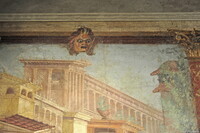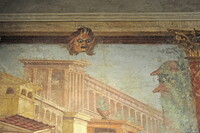| dc.coverage.spatial | Site: Metropolitan Museum of Art (New York, New York, United States) 03.14.13a-g | en_US |
| dc.coverage.spatial | Former Site: Boscoreale, Campania, Italy, Europe, | en_US |
| dc.coverage.temporal | ca. 40-30 BCE (creation) | en_US |
| dc.creator | unknown (Ancient Roman) | en_US |
| dc.date | -40--30 | en_US |
| dc.date.accessioned | 2015-01-06T15:11:38Z | |
| dc.date.available | 2015-01-06T15:11:38Z | |
| dc.date.issued | -40--30 | en_US |
| dc.identifier | 256413 | en_US |
| dc.identifier.other | archrefid: 3165 | en_US |
| dc.identifier.uri | http://hdl.handle.net/1721.3/172365 | |
| dc.description | Detail of illusionistic architecture expanding in three dimensional space; a large arcade or stoa is at the top along with the mask of tragedy (Melpomene); The frescoes were excavated in 1899-1900, by Vincenzo de Prisco. They were acquired by the museum in August 1903, purchased from C. and E. Canessa, Paris. Boscoreale is a Roman town on the southern slope of Mt. Vesuvius immediately to the north and about a mile from Pompeii. Excavations carried out mainly in the later 19th century brought to light some thirty villae rusticae, part of an intense network of smallholdings situated on the lower slopes of the volcano and the adjacent Sarno plain. Most of the villas were reburied after the excavations. Perhaps the most famous residence at Boscoreale is the so-called Villa of Fannius Synistor (the attribution is by no means certain), lavishly decorated with frescoes in the late Second Style in ca. 40-30 BCE. The frescoes employ both architectural details and objects of everyday life in a trompe l'oeil style such as columns that cast shadows into the viewer's space. Second Style (ca. 80-15 BCE) was characterized by the expansion of the picture plane into a three-dimensional space, opening on to architectural vistas or mythological scenes. Source: Grove Art Online; http://www.oxfordartonline.com/ (accessed 4/29/2014) | en_US |
| dc.format.medium | fresco (pigment on plaster); stone mosaic floor | en_US |
| dc.rights | © Scott Gilchrist, Archivision, Inc. | en_US |
| dc.subject | architecture | en_US |
| dc.subject | genre | en_US |
| dc.subject | landscape | en_US |
| dc.subject | mythology (Classical) | en_US |
| dc.subject | interior design | en_US |
| dc.subject | Late Republican | en_US |
| dc.subject | Second Style | en_US |
| dc.title | Cubiculum (bedroom) from the Villa of P. Fannius Synistor at Boscoreale | en_US |
| dc.title.alternative | Bedroom from Boscoreale | en_US |
| dc.type | image | en_US |
| dc.rights.access | Licensed for educational and research use by the MIT community only | en_US |
| dc.identifier.vendorcode | 7A3-MMA-R-WFF-A11 | en_US |
| vra.culturalContext | Ancient Roman | en_US |
| vra.technique | construction (assembling), fresco painting (technique) | en_US |
| vra.worktype | fresco (painting) | en_US |
| vra.worktype | cubiculum | en_US |
| dc.contributor.display | unknown (Ancient Roman) | en_US |

